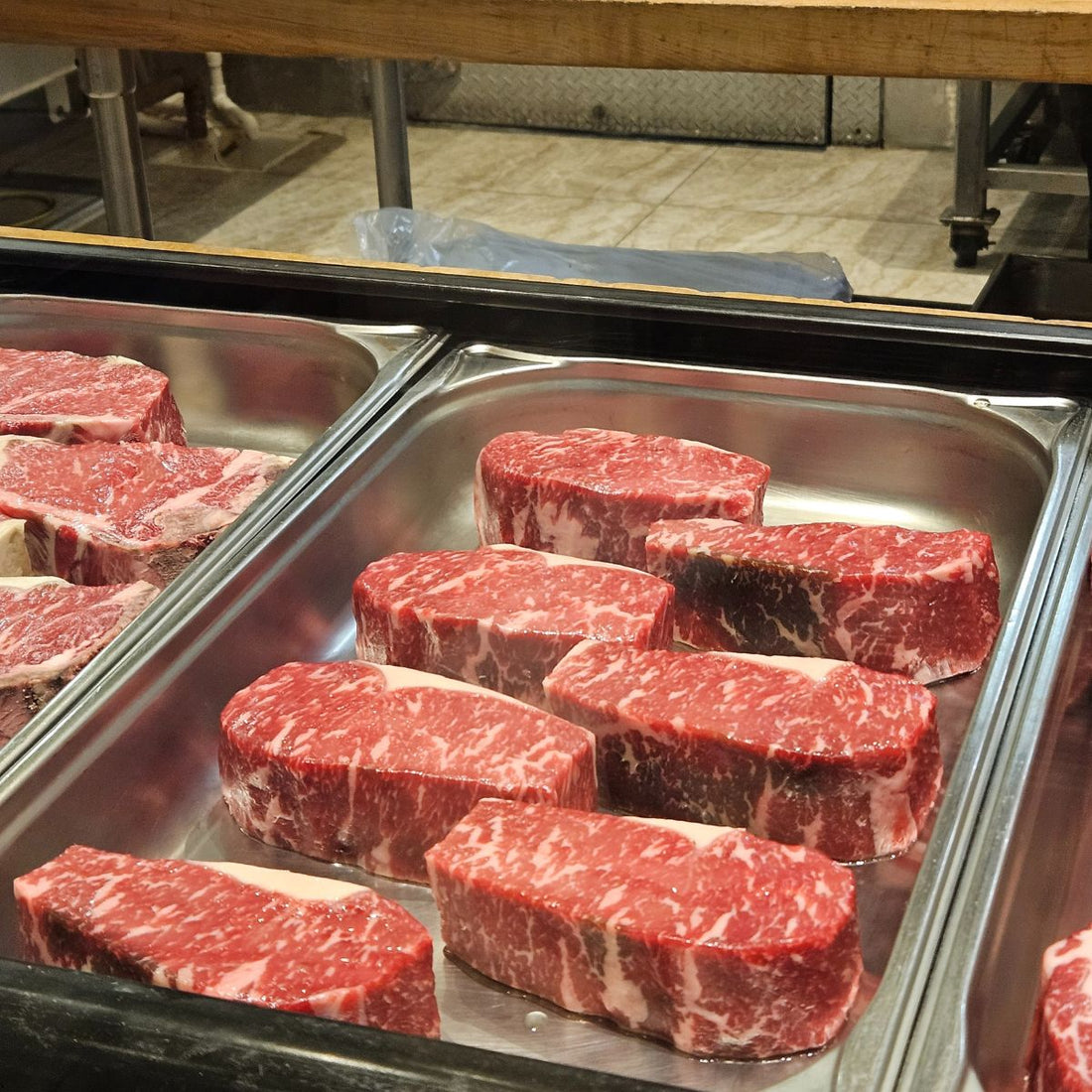Dive into the delicious world of ribeye steaks, where indulgence meets calorie consciousness. This guide uncovers the art of balancing rich, savory flavors with mindful calorie counting, whether you're grilling in the backyard or searing on a cast-iron skillet.
A 4-ounce serving of ribeye steak contains approximately 300 calories, which includes about 20 grams of protein and 24 grams of fat. However ribeye steaks are usually served in 8oz - 12oz portions, sometimes more. For some quick math:
- 4oz = 300 calories, 20g protein, 24g fat
- 8oz = 600 calories, 40g protein, 48g fat
- 12oz = 900 calories, 60g protein, 72g of fat
- NOTE: the fat is highly dependent on the marbling of the steak itself, and it is easy to avoid eating it when you carve into your steak, so do not let the numbers of fat scare you.
The Ultimate Guide to Ribeye Steak
Behold the ribeye, the jewel in the crown of best cuts of beef! Embraced by chefs and connoisseurs alike, the ribeye cut commands respect through its remarkable marbling and flavor profile. Settling for just any steak is like choosing a three-speed bike when you could be riding a sleek roadster - why do that when you have the chance to indulge in the best?
Why Ribeye is the King of Steaks
You might wonder what makes the Certified Angus Beef ribeye reign supreme on the throne of steaks. Imagine every bite melting in your mouth, releasing a festival of flavors that dance across your palate. Its royalty is adorned by marbling that ensures each slice is richly veined with flavors only nature can conjure. This opulent texture not only infuses juiciness but catapults its status beyond mere meat—it becomes a gourmet experience.
Choosing the Right Ribeye Cut
When your appetite craves quality, only the best will do. Every steak lover knows that excellent cattle breeding translates to superior steak, and labels like Choice or Prime grades signify a celestial experience awaiting your plate. Yet, if your palate beckons for something less indulgent but equally compelling, the grass fed ribeye steak shines as a superior selection. Pioneering a new path through the meadows of meat, its leaner composition, and quicker cook time still delivers on taste without compromising on sophistication.

Armed with this meaty knowledge, when next you saunter into your local butchery, or peruse the gourmet menu, remember the power lies in your hands. Selecting the right ribeye comes down to your lifestyle choices, flavor precedent, and whether you prefer the Cadillac of beef, or a more environmentally friendly conveyance of carnivorous delight.
Nutritional Breakdown of Ribeye Steak
A 4-ounce serving of ribeye steak contains approximately 300 calories, which includes about 20 grams of protein and 24 grams of fat. The high fat content, primarily from the marbling that gives ribeye its signature flavor and tenderness, contributes significantly to its calorie count. This is why ribeye is often considered a more indulgent choice compared to leaner cuts.
Protein and Fat Content
The protein in ribeye steak is of high quality, offering essential amino acids that support muscle growth and repair. However, the fat content, particularly saturated fat, should be considered by those monitoring their heart health or cholesterol levels. The balance of protein and fat makes ribeye a satisfying meal, but it also means moderation is key.
Cooking Methods and Calorie Content
The way you cook ribeye can affect its calorie content. Grilling or broiling without additional fats is a healthier choice compared to pan-frying, which may add extra calories from oils or butter. Also, trimming excess fat before cooking can reduce calorie intake while still allowing you to enjoy the steak’s innate flavor.
Ribeye Steak Calories Unveiled
Ribeye steak, known for its delicious marbling, packs about 300 calories in a 4-ounce serving and 600 calories in an 8-ounce portion. This higher calorie content is largely due to the flavorful marbling that makes ribeye so appealing. Despite the calorie count, ribeye offers nutritional benefits, including a robust amount of protein, vitamins, and minerals.
Understanding these nutritional aspects helps you appreciate what you're indulging in and can guide more informed dietary choices when enjoying this savory cut of beef.
Choice of Beef Cut and Nutritional Profile
When considering different cuts of beef, it's essential to understand their nutritional profiles, which can significantly impact dietary choices and goals. Here's a breakdown of the nutritional information for each cut based on a 4-ounce serving:
-
Ribeye Steak: With 300 calories, 20 grams of protein, and 24 grams of fat, ribeye is a rich and flavorful cut known for its marbling. It's a sumptuous choice for those seeking a tender texture and robust taste but may not be ideal for low-fat diets.
-
Tenderloin: This leaner option offers 220 calories, 24 grams of protein, and 14 grams of fat. Known for its tenderness, tenderloin is a great choice for those looking to enjoy a luxurious cut with less fat, making it suitable for more balanced dietary plans.
-
Sirloin: Sirloin provides 210 calories, 22 grams of protein, and 13 grams of fat. It's a popular choice for those wanting a good balance of flavor and leanness, offering a healthy protein source with moderate fat content. Curious about the difference between Sirloin and Ribeye? Discover more in our guide: Sirloin vs Ribeye: What's the Difference?
-
Flank: At 160 calories, 22 grams of protein, and 7 grams of fat, flank steak is the leanest option among these cuts. It's ideal for those on calorie-conscious diets or looking to maintain lower fat intake while still enjoying a robust beef flavor.
-
T-Bone: This indulgent cut contains 450 calories, 19 grams of protein, and 36 grams of fat. It's a treat for those who prioritize flavor and richness, but its high fat and calorie content make it less suitable for those watching their intake.
As eye-opening as this table is, remember that flavor has no direct correlation with calorie count. A well-marbled ribeye speaks to the soul in ways a leaner cut can't even whisper. So next time you're contemplating a walk on the rich side, relish every bite. Your ribeye awaits, ready to tantalize your palate and, dare we say, justify every last calorie.

Tips for Enjoying Ribeye While Managing Calories
- Portion Control: Consider sharing a ribeye steak or opting for a smaller cut to enjoy the flavor without excessive calories.
- Pair with Vegetables: Balance your meal with a side of steamed or roasted vegetables. This not only adds nutritional value but also helps fill you up with fewer calories.
- Lean Towards Lean: Occasionally, choose leaner cuts of beef for a lower-calorie alternative, saving ribeye for special occasions.
- Mindful Cooking: Use methods like grilling or broiling to minimize added fats. If using a skillet, consider a non-stick option or use minimal oil. Enhance your ribeye with the Salt-Free Seasoning Gift Collection from Virginia Boys Kitchens for a rich taste without added calories.
Ribeye in a Balanced Diet
Incorporating ribeye steak into a balanced diet is possible with mindful choices. Its rich flavor can be a delightful part of a varied meal plan, especially when paired with nutrient-dense foods. Consider the overall composition of your diet and aim for variety to ensure you’re getting a wide range of nutrients.
Health Considerations
While ribeye is delicious, it's important for individuals with specific health concerns, such as heart disease or weight management goals, to consider the saturated fat content. Consulting with a healthcare provider or nutritionist can help tailor dietary choices that fit personal health needs.
FAQ
Why is ribeye often coined the king of steaks?
Ah, the nobility of ribeye cannot be overstated. With its lavish marbling and opulent flavor, ribeye sits on the throne due to its blend of texture, taste, and tenderness that few other cuts can match.
What's the caloric deal with a slab of ribeye?
Don't let the calories haunt you; consider them a testament to the steak's rich flavor. A standard 4-ounce cut packs around 300 calories, which of course doubles for its bigger 8-ounce sibling at 600 calories.
Is choosing Certified Angus Beef ribeye really worth it?
Absolutely, my discerning friend. If you’re after consistency and top-tier marbling, Certified Angus Beef is your ticket to a premium ribeye experience. However, don't overlook Choice or Prime grades for a dazzling steak rendezvous.
Can you spill the beans on acing the perfect grilled ribeye?
The secret's out! Bring your ribeye to room temp before introducing it to a scorching grill for that perfect sear. Then, let the delicate dance of the flames cook it through without charring its gorgeous exterior.
What's the deal with steak doneness and how do I hit that sweet spot?
Steak doneness is a personal affair, darling. Temperatures from 125°F for a bashful rare to a confident 160°F for well-done will have you swooning. Use a meat thermometer, and remember, patience begets the juiciest returns.
Is it really just salt that's needed to make my ribeye sing?
Kosher salt is the solo artist that can bring out the symphony in your steak. Still, if you're feeling jazzy, spice blends like Sazon and Fajita seasonings can be your backup singers, adding depth without overshadowing the lead.
How do I make my ribeye rest without making it cold and sad?
It’s a fine art! After cooking, place your precious ribeye on a wire rack to rest and let those juices settle back in. Think of it as a steak spa - it comes out rejuvenated, moist, and warm, not cold or blue.
Any bright ideas for sidekicks that’ll jazz up my ribeye meal?
Oh, you’re setting the stage for a culinary cabaret! Think Crispy Smashed Potatoes for a rich harmony, or a vibrant salad for a refreshing duet. Your ribeye deserves the perfect ensemble of sides.
I've got leftover ribeye. What's the magic trick for enjoying it the next day?
Leftover ribeye can be a delight, not a disaster. Store it in an airtight container and gently reheat at 300°F to retain that first-day magic. It’s about recreating the experience, not just reheating the meat.
Conclusion
Ribeye steak is a culinary delight that can be part of a balanced diet when enjoyed mindfully. By understanding its nutritional profile and making informed cooking and serving choices, you can savor this flavorful cut while managing your calorie intake. Whether enjoyed occasionally or as a special treat, ribeye steak can offer a satisfying dining experience without derailing dietary goals.
See Virginia Boys Kitchens On Amazon
We are on Amazon, see our storefront here. Use coupon code VBKBLOG10 for 10% off your entire purchase of any Virginia Boys Kitchens on Amazon. Apply the code at checkout.




